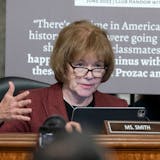From the window of her State Capitol office, Lt. Gov. Peggy Flanagan has a prime view of the towering bronze likeness of Knute Nelson, a "brave son of Norway" in the words of the statue's engraving, who served Minnesota as a legislator, congressman, governor and eventually U.S. senator.
Among this Minnesota forefather's accomplishments in Congress: the Nelson Act of 1889, which relocated Indigenous Minnesotans to the White Earth Reservation and sold their land to European settlers.
"That's something," said Flanagan, the first Native American statewide elected official in Minnesota's history. "I don't think the author of the Nelson Act could have imagined there would be an Ojibwe woman staring out the window at a statue of him."
Near Nelson's spot on the Capitol mall, a statue of Christopher Columbus stood until the middle of June, toppled by a group of activists who saw a symbol of Native American genocide in the discredited idea that he "discovered" America. It was one incident in a sweeping racial reckoning that has followed the Memorial Day killing of George Floyd by Minneapolis police officers, one that's prompted a worldwide re-examination of things ranging from policing practices to who we memorialize — or don't — in public spaces.
In the 115-year history of Minnesota's Capitol building, memorials have only ever been added, never subtracted. And as the state has grown more diverse, the cast of sculpted faces that greet tens of thousands of visitors yearly has not.
That could soon change. Flanagan is at the heart of the debate as designated chairwoman of the state panel that approves new memorials, and which under her direction is crafting a process that could lead to the removal of some of the two dozen statues and memorials spread across the sprawling Capitol grounds.
"It's an opportunity for us to take this moment and take this spotlight that is shining on the board and really run with it," Flanagan said. "The structures and the systems have to be able to respond to the changing demographics and the changing viewpoints that weren't included, frankly, when many of these statues and monuments went up."
All over the world, statues are falling. In Boston, a Columbus statue was recently beheaded. Black Lives Matter demonstrators in Bristol, England, tore down a statue of slave trader Edward Colston and threw it into a harbor. The Minnesota Twins recently removed a Target Field statue of Calvin Griffith, a former owner with a well-documented history of racist remarks.


